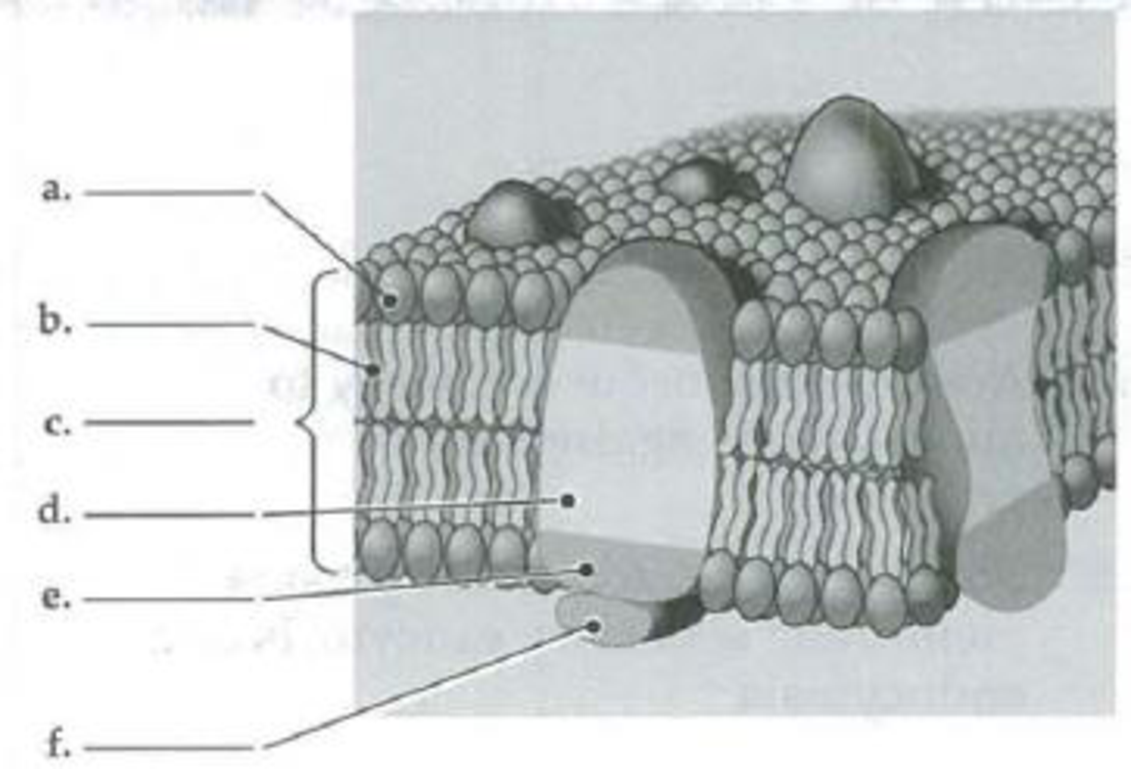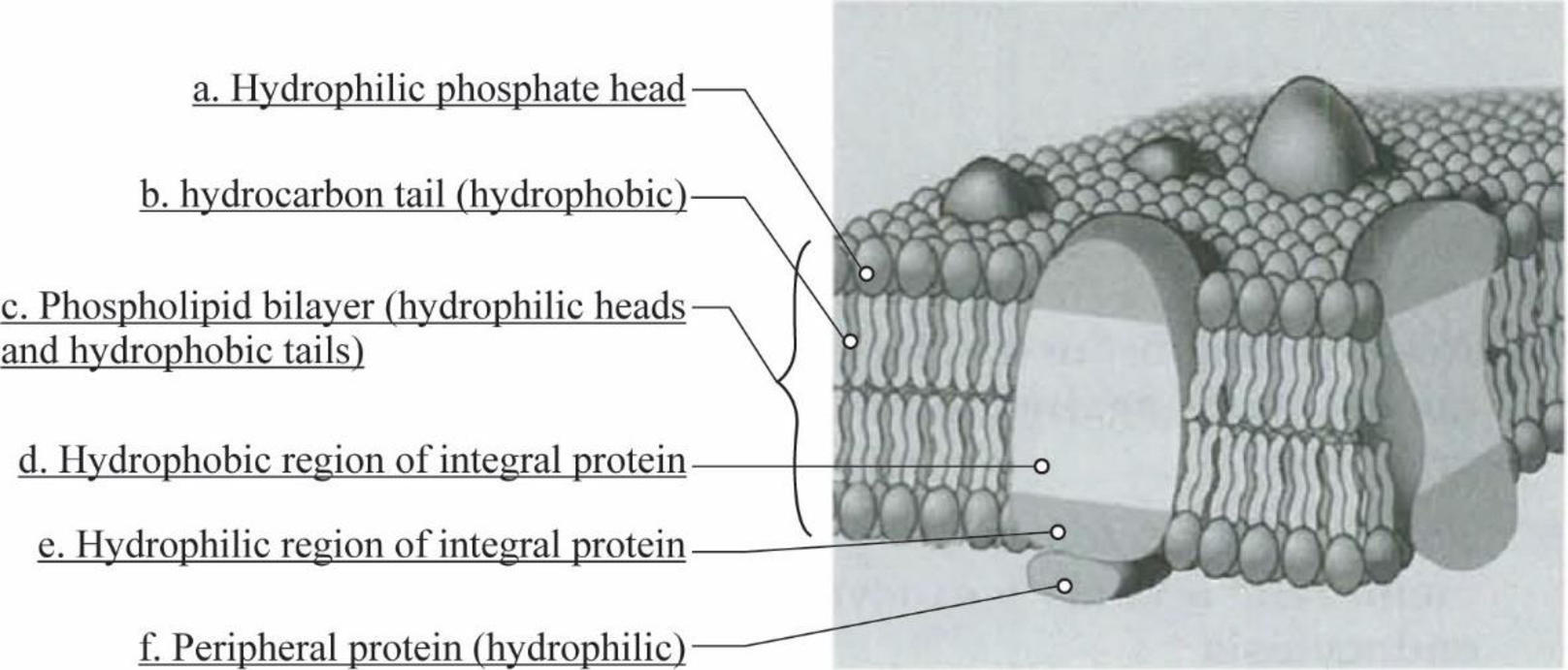
Concept explainers
Label the components in the following diagram of a small portion of a plasma membrane. Indicate whether regions are hydrophobic or hydrophilic.

To label: The components in the given diagram of a small portion of a plasma membrane and indicate whether the regions are hydrophobic or hydrophilic.
Introduction: All living organisms are made up of one or many cells. The organisms are classified as prokaryotes and eukaryotes. The prokaryotes are usually unicellular including the bacteria and archaea, while the eukaryotes are usually multicellular including the plants and animals. The prokaryotic cells are simpler and smaller than the eukaryotic cells.
Answer to Problem 1IQ
Pictorial representation: Fig.1 illustrates the diagram of a small portion of plasma membrane.

Fig.1: Plasma membrane
Explanation of Solution
Plasma membrane is a selectively permeable membrane with lipid bilayer and protein. The lipid bilayer structure is a barrier structure. Lipid molecule consists of the polar head region called hydrophilic head, and a non-polar fatty acid chain tail called hydrophobic tail. The hydrophilic region is attracted toward aqueous condition, and the hydrophobic end is repelled away from the aqueous condition.
Membrane proteins are a part of biological membrane that primarily interacts with it to perform various functions in the cell. There are various membrane proteins that help in the transportation of molecules in and out of the cell. Based on the extend of attachment to the membrane, the membrane proteins are classified as integral proteins, peripheral proteins, and transmembrane proteins.
- Integral membrane proteins: Integral membrane proteins are a type of membrane proteins that are firmly bound to the membrane. These types of proteins are amphipathic in nature. Here, the hydrophilic head region is extended out of the cell, and its hydrophobic tail region interacts with the fatty acids present on the membrane phospholipids.
- Transmembrane proteins: Transmembrane proteins extend completely through the membrane. These types of proteins majorly function on both sides of the layer (intracellular and extracellular) and help to transport molecules across it.
- Peripheral membrane proteins: Peripheral membrane proteins are located on the inner and outer surfaces of the plasma membrane, and are not embedded in the lipid bilayer as the other membrane proteins. They bound to the exposed regions of the integral proteins through non-covalent interactions.
Want to see more full solutions like this?
Chapter 7 Solutions
Study Guide for Campbell Biology
- The tails of the phospholipids of the plasma membrane are composed of _____ and are _____? a. phosphate groups; hydrophobic b. fatty acid groups; hydrophilic c. phosphate groups; hydrophilic d. fatty acid groups; hydrophobicarrow_forwardCell membranes consist mainly of a _________. a. carbohydrate bilayer and proteins b. protein bilayer and phospholipids c. phospholipid bilayer and proteinsarrow_forwardIn the fluid mosaic model: plasma membrane proteins orient their hydrophilic sides toward the internal bilayer. phospholipids often flip-flop between the inner and outer layers. the mosaic refers to proteins attached to the underlying cytoskeleton. the fluid refers to the phospholipid bilayer. the mosaic refers to the symmetry of the internal membrane proteins and sterols.arrow_forward
- Which of the following methods of transport is being used to transfer the substance into the cell in the accompanying graph? a. diffusion down a concentration gradient b. osmosis c. facilitated diffusion d. active transport e. vesicular transport f. It is impossible to tell with the information provided.arrow_forwardWhy is it advantageous for the cell membrane to be fluid in nature?arrow_forwardPut the following structures in order according to the pathway of a secreted protein: a. plasma membrane b. Golgi bodies c. endoplasmic reticulum d. post-Golgi vesiclesarrow_forward
- Which of the following is not a component of the endomembrane system? a. mitochondrion b. Golgi apparatus c. endoplasmic reticulum d. Iysosomearrow_forwardCell membranes consists mainly of ________ and ________ . a. lipids; carbohydrates c. lipids; phospholipids b. phospholipids; protein d. phospholipids; ECMarrow_forwardAssign a function(s) to the following cellular structures: a. plasma membrane b. mitochondrion c. nucleus d. ribosomearrow_forward
- No animal cell has a ______. a. plasma membrane b. flagellum c. lysosome d. cell wallarrow_forwardDistinguish between the following pairs of terms: a. diffusion; osmosis b. passive transport; active transport c. endocytosis; exocytosisarrow_forwardThe passive movement of a solute through a membrane protein down its concentration gradient is an example of _________. a. osmosis b. active transport c. endocytosis d. diffusionarrow_forward
 Human Heredity: Principles and Issues (MindTap Co...BiologyISBN:9781305251052Author:Michael CummingsPublisher:Cengage Learning
Human Heredity: Principles and Issues (MindTap Co...BiologyISBN:9781305251052Author:Michael CummingsPublisher:Cengage Learning Biology Today and Tomorrow without Physiology (Mi...BiologyISBN:9781305117396Author:Cecie Starr, Christine Evers, Lisa StarrPublisher:Cengage Learning
Biology Today and Tomorrow without Physiology (Mi...BiologyISBN:9781305117396Author:Cecie Starr, Christine Evers, Lisa StarrPublisher:Cengage Learning Concepts of BiologyBiologyISBN:9781938168116Author:Samantha Fowler, Rebecca Roush, James WisePublisher:OpenStax College
Concepts of BiologyBiologyISBN:9781938168116Author:Samantha Fowler, Rebecca Roush, James WisePublisher:OpenStax College Human Biology (MindTap Course List)BiologyISBN:9781305112100Author:Cecie Starr, Beverly McMillanPublisher:Cengage Learning
Human Biology (MindTap Course List)BiologyISBN:9781305112100Author:Cecie Starr, Beverly McMillanPublisher:Cengage Learning Human Physiology: From Cells to Systems (MindTap ...BiologyISBN:9781285866932Author:Lauralee SherwoodPublisher:Cengage Learning
Human Physiology: From Cells to Systems (MindTap ...BiologyISBN:9781285866932Author:Lauralee SherwoodPublisher:Cengage Learning





